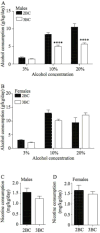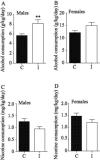Voluntary co-consumption of alcohol and nicotine: Effects of abstinence, intermittency, and withdrawal in mice
- PMID: 27342124
- PMCID: PMC5842373
- DOI: 10.1016/j.neuropharm.2016.06.023
Voluntary co-consumption of alcohol and nicotine: Effects of abstinence, intermittency, and withdrawal in mice
Abstract
Alcohol and nicotine are often used together, and there is a high rate of co-occurrence between alcohol and nicotine addiction. Most animal models studying alcohol and nicotine interactions have utilized passive drug administration, which may not be relevant to human co-addiction. In addition, the interactions between alcohol and nicotine in female animals have been understudied, as most studies have used male animals. To address these issues, we developed models of alcohol and nicotine co-consumption in male and female mice that utilized voluntary, oral consumption of unsweetened alcohol, nicotine and water. We first examined drug consumption and preference in single-drug, sequential alcohol and nicotine consumption tests in male and female C57BL/6 and DBA/2J mice. We then tested chronic continuous and intermittent access alcohol and nicotine co-consumption procedures. We found that male and female C57BL/6 mice readily co-consumed unsweetened alcohol and nicotine. In our continuous co-consumption procedures, we found that varying the available nicotine concentration during an alcohol abstinence period affected compensatory nicotine consumption during alcohol abstinence, and affected rebound alcohol consumption when alcohol was re-introduced. Consumption of alcohol and nicotine in an intermittent co-consumption procedure produced higher alcohol consumption levels, but not nicotine consumption levels, compared with the continuous co-consumption procedures. Finally, we found that intermittent alcohol and nicotine co-consumption resulted in physical dependence. Our data show that these voluntary co-consumption procedures can be easily performed in mice and can be used to study behavioral interactions between alcohol and nicotine consumption, which may better model human alcohol and nicotine co-addiction.
Keywords: Abstinence; Alcohol; Consumption; Intermittent; Nicotine; Withdrawal.
Copyright © 2016 Elsevier Ltd. All rights reserved.
Figures







Similar articles
-
Unequal interactions between alcohol and nicotine co-consumption: suppression and enhancement of concurrent drug intake.Psychopharmacology (Berl). 2020 Apr;237(4):967-978. doi: 10.1007/s00213-019-05426-6. Epub 2019 Dec 20. Psychopharmacology (Berl). 2020. PMID: 31858160 Free PMC article.
-
Chronic intermittent ethanol inhalation increases ethanol self-administration in both C57BL/6J and DBA/2J mice.Alcohol. 2015 Mar;49(2):111-20. doi: 10.1016/j.alcohol.2015.01.003. Epub 2015 Jan 21. Alcohol. 2015. PMID: 25659650 Free PMC article.
-
The nicotinic receptor drug sazetidine-A reduces alcohol consumption in mice without affecting concurrent nicotine consumption.Neuropharmacology. 2018 May 1;133:63-74. doi: 10.1016/j.neuropharm.2018.01.019. Epub 2018 Feb 2. Neuropharmacology. 2018. PMID: 29355641 Free PMC article.
-
Sex Differences in Mouse Models of Voluntary Alcohol Drinking and Abstinence-Induced Negative Emotion.Alcohol. 2024 Dec;121:45-57. doi: 10.1016/j.alcohol.2024.07.004. Epub 2024 Jul 23. Alcohol. 2024. PMID: 39053705 Review.
-
Induction of physical dependence upon alcohol in nonhuman primates.Adv Exp Med Biol. 1975;56:327-37. doi: 10.1007/978-1-4684-7529-6_17. Adv Exp Med Biol. 1975. PMID: 1096555 Review.
Cited by
-
Socially Integrated Polysubstance (SIP) system: An open-source solution for continuous monitoring of polysubstance fluid intake in group housed mice.Addict Neurosci. 2023 May 5;7:10.1016/j.addicn.2023.100101. doi: 10.1016/j.addicn.2023.100101. Addict Neurosci. 2023. PMID: 37560335 Free PMC article.
-
Assessing nicotine dependence using an oral nicotine free-choice paradigm in mice.Neuropharmacology. 2019 Oct;157:107669. doi: 10.1016/j.neuropharm.2019.107669. Epub 2019 Jun 18. Neuropharmacology. 2019. PMID: 31220484 Free PMC article.
-
Bidirectional sex-dependent regulation of α6 and β3 nicotinic acetylcholine receptors by protein kinase Cε.Addict Biol. 2021 May;26(3):e12954. doi: 10.1111/adb.12954. Epub 2020 Aug 10. Addict Biol. 2021. PMID: 32776643 Free PMC article.
-
Animal Models to Investigate the Impact of Flavors on Nicotine Addiction and Dependence.Curr Neuropharmacol. 2022;20(11):2175-2201. doi: 10.2174/1570159X20666220524120231. Curr Neuropharmacol. 2022. PMID: 35611777 Free PMC article. Review.
-
Differential patterns of alcohol and nicotine intake: Combined alcohol and nicotine binge consumption behaviors in mice.Alcohol. 2020 Jun;85:57-64. doi: 10.1016/j.alcohol.2019.09.006. Epub 2019 Sep 23. Alcohol. 2020. PMID: 31557515 Free PMC article.
References
-
- Batel P, Pessione F, Maitre C, Rueff B. Relationship between alcohol and tobacco dependencies among alcoholics who smoke. Addiction. 1995;90:977–980. - PubMed
-
- Bhutada PS, Mundhada YR, Bansod KU, Umathe SN, Kahale VP, Dixit PV, Mundhada DR. Inhibitory influence of mecamylamine on ethanol withdrawal-induced symptoms in C57BL/6J mice. Behav Pharmacol. 2010;21:90–95. - PubMed
-
- Blomqvist O, Ericson M, Johnson DH, Engel JA, Soderpalm B. Voluntary ethanol intake in the rat: effects of nicotinic acetylcholine receptor blockade or subchronic nicotine treatment. Eur J Pharmacol. 1996;314:257–267. - PubMed
-
- Burling TA, Ziff DC. Tobacco smoking: a comparison between alcohol and drug abuse inpatients. Addict Behav. 1988;13:185–190. - PubMed
Publication types
MeSH terms
Substances
Grants and funding
LinkOut - more resources
Full Text Sources
Other Literature Sources
Medical

